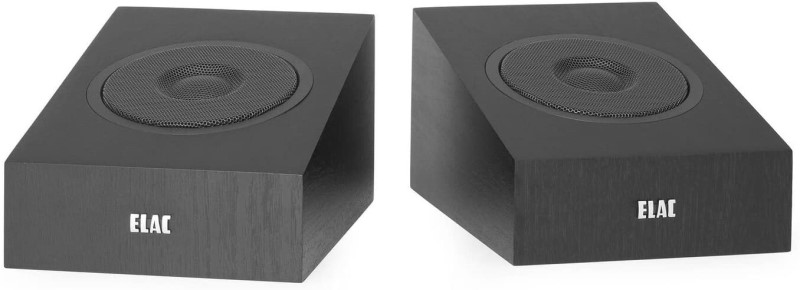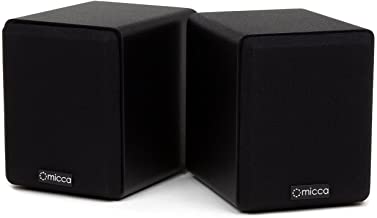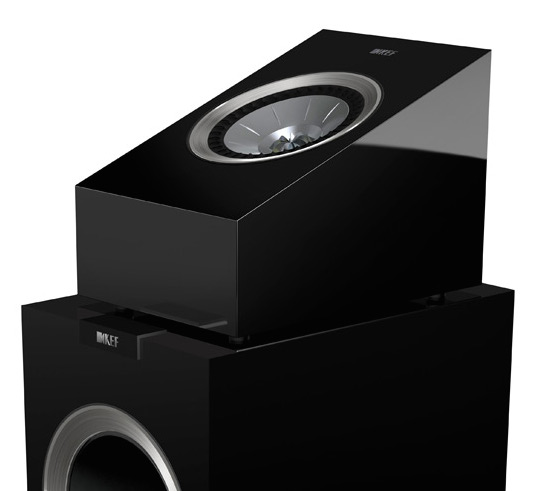Upfiring Atmos Modules as Surrounds – Can it Work?
You’ve come into possession of some upfiring Atmos speakers. You know the ones. They are meant to be placed on top of your other speakers to provide “simulated” overhead speakers? The problem is that you don’t want overhead speakers. What you really want is surround speakers. Can these upfiring Atmos modules work as surrounds? How can you use them? Let’s discuss!
The Differences Between Atmos Modules and Surround Speakers
The first, and most obvious difference between upfiring Atmos modules and traditional surround speakers is the shape. An Atmos module is designed to sit on a shelf or (as is generally shown in the marketing literature) on top of another speaker. This means that the speaker is angled so that the sound can “bounce” off the ceiling.


Traditional surrounds don’t look anything like Atmos modules (generally). If anything, they usually look like bookshelf speakers. They are usually smaller than bookshelf speakers, but not always.
The other main difference that you can’t see is internal. Upfiring Atmos modules often look and work differently than surrounds. They rely on an HRTF to provide the simulated overhead sounds. While that doesn’t necessarily mean that they are tuned differently than other speakers, it does mean that the frequency range that Atmos speakers reproduce is different than what we’d expect from surrounds. While more recent Atmos speakers have begun to look like and work more similarly to surrounds, early upfiring Atmos modules often had truncated performance focusing solely on the frequencies that Dolby said were important for Atmos.
The Two Ways to Use Your Atmos Modules as Surrounds
There are two ways to use your Atmos speakers as surrounds. The first is to mount them to the wall (or ceiling) and the second is to set them up as you would an upfiring Atmos speaker but wiring them differently.
Traditional Placement
Newer upfiring Atmos modules have begun to work more similarly to surrounds than the early models. This means you’ll often find keyhole mounts and other mounting options integrated into the speaker. It makes sense. Why sell a speaker that can ONLY be used as an Atmos module when you can sell one that can work as an upfiring speaker or a traditional surround? Take, for example, the Klipsch RP-500SA.
These speakers can be used as Atmos modules or mounted on the wall for surround duties. They have a switch on the back to select between the different configurations. A keyhole mount is included for wall mounting. These are certainly perfect for either upfiring or traditional placement.
But even if you have older Atmos modules, using them as surrounds is certainly feasible. You’ll get surround effects that you didn’t have before. Will they be perfectly timbre-matched with the rest of your speakers? Probably not. But who cares? Something is better than nothing! The only thing to consider when using these speakers as surrounds are the angle of the front baffle. Be careful when you mount them so that they are firing in your general direction. You don’t want to be sitting too far off-axis.
Upfiring Placement
Let’s say you want surround speakers but you just can’t run wires across the room. You’ve got these Atmos modules. Is there anything you can do?
There is!
While it is certainly not the recommended placement, if you have no other choice, set your Atmos modules on top of your front speakers as recommended. Instead of hooking the upfiring Atmos modules to your overhead channels, connect them to your surround channels instead. Atmos module effectiveness is highly dependent on many factors, but it can simulate surround sound fairly well in the right situation.

This setup will send your surround sounds through your Atmos modules. We’ve had listeners of the AV Rant podcast report that they’ve tried it with some success. Remember, this is a method of last resort. If you have no other way of getting surround speakers in your system, you can try this out and see if it works for you. While you are at it, also try a 3.1.2 system. That might actually sound better.



